Robust and Precise Matching Algorithm Combining Absent Color Indexing and Correlation Filter
Abstract
1. Introduction
2. Absent Color Indexing
2.1. Why Are Minor Colors Important?
2.2. Color Space Selection
2.3. Apparent and Absent Color Histograms
2.4. Design of Threshold
2.5. Histogram Intersection
3. Combination of ABC with CF
4. Experiments
4.1. Experimental Comparison with Color Histogram-Based Methods
4.2. ABC-CF in Open Data
4.3. Computation Cost
5. Conclusions
Author Contributions
Funding
Institutional Review Board Statement
Informed Consent Statement
Data Availability Statement
Conflicts of Interest
References
- Wiley, V.; Lucas, T. Computer vision and image processing: A paper review. Int. J. Artif. Intell. Res. 2018, 2, 29–36. [Google Scholar] [CrossRef]
- O’Mahony, N.; Campbell, S.; Carvalho, A.; Harapanahalli, S.; Hernandez, G.V.; Krpalkova, L.; Riordan, D.; Walsh, J. Deep learning vs. traditional computer vision. In Science and Information Conference; Springer: Berlin/Heidelberg, Germany, 2019; pp. 128–144. [Google Scholar]
- Liu, P.; Guo, J.M.; Chamnongthai, K.; Prasetyo, H. Fusion of color histogram and LBP-based features for texture image retrieval and classification. Inf. Sci. 2017, 390, 95–111. [Google Scholar] [CrossRef]
- Zivkovic, Z.; Krose, B. An EM-like algorithm for color-histogram-based object tracking. In Proceedings of the 2004 IEEE Computer Society Conference on Computer Vision and Pattern Recognition, 2004. CVPR 2004, Washington, DC, USA, 27 June–2 July 2004; Volume 1, p. I. [Google Scholar]
- Jia, W.; Zhang, H.; He, X.; Wu, Q. A comparison on histogram based image matching methods. In Proceedings of the 2006 IEEE International Conference on Video and Signal Based Surveillance, Sydney, NSW, Australia, 22–24 November 2006; p. 97. [Google Scholar]
- Tyagi, V. Content-Based Image Retrieval; Springer: Berlin/Heidelberg, Germany, 2017. [Google Scholar]
- Swain, M.J.; Ballard, D.H. Indexing via color histograms. In Active Perception and Robot Vision; Springer: Berlin/Heidelberg, Germany, 1992; pp. 261–273. [Google Scholar]
- Stricker, M.A.; Orengo, M. Similarity of color images. In Storage and Retrieval for Image and Video Databases III; International Society for Optics and Photonics: Washington, DC, USA, 1995; Volume 2420, pp. 381–393. [Google Scholar]
- Han, J.; Ma, K.K. Fuzzy color histogram and its use in color image retrieval. IEEE Trans. Image Process. 2002, 11, 944–952. [Google Scholar] [CrossRef] [PubMed]
- Küçüktunç, O.; Güdükbay, U.; Ulusoy, Ö. Fuzzy color histogram-based video segmentation. Comput. Vis. Image Underst. 2010, 114, 125–134. [Google Scholar] [CrossRef]
- Mayathevar, K.; Veluchamy, M.; Subramani, B. Fuzzy color histogram equalization with weighted distribution for image enhancement. Optik 2020, 216, 164927. [Google Scholar] [CrossRef]
- Veluchamy, M.; Subramani, B. Fuzzy dissimilarity color histogram equalization for contrast enhancement and color correction. Appl. Soft Comput. 2020, 89, 106077. [Google Scholar] [CrossRef]
- Verma, N.K.; Goyal, A.; Chaman, A.; Sevakula, R.K.; Salour, A. Template matching for inventory management using fuzzy color histogram and spatial filters. In Proceedings of the 2015 IEEE 10th Conference on Industrial Electronics and Applications (ICIEA), Auckland, New Zealand, 15–17 June 2015; pp. 317–322. [Google Scholar]
- Hisham, M.; Yaakob, S.N.; Raof, R.A.; Nazren, A.A. Template matching using sum of squared difference and normalized cross correlation. In Proceedings of the 2015 IEEE student conference on research and development (SCOReD), Kuala Lumpur, Malaysia, 13–14 December 2015; pp. 100–104. [Google Scholar]
- El-Hallaq, M.A. A proposed template image matching algorithm for face recognition. In Proceedings of the 2019 IEEE 7th Palestinian International Conference on Electrical and Computer Engineering (PICECE), Gaza, Palestine, 26–27 March 2019; pp. 1–6. [Google Scholar]
- Zhang, H.; Liu, G.; Hao, Z. Robust visual tracking via multi-feature response maps fusion using a collaborative local-global layer visual model. J. Vis. Commun. Image Represent. 2018, 56, 1–14. [Google Scholar] [CrossRef]
- Gan, W.; Lee, M.S.; Wu, C.H.; Kuo, C.C.J. Online object tracking via motion-guided convolutional neural network (MGNet). J. Vis. Commun. Image Represent. 2018, 53, 180–191. [Google Scholar] [CrossRef]
- Tian, Y.; Kaneko, S.; Sasatani, S.; Itoh, M. Robust Picture Search by Absent Color Indexing. In Proceedings of the Seventh Asia International Symposium on Mechatronics; Springer: Singapore, 2020; pp. 860–866. [Google Scholar]
- Tian, Y.; Kaneko, S.; Sasatani, S.; Itoh, M.; Fang, M. Reliable and Accurate Pattern Search by Combination of Absent Color Indexing with Correlation Filter. In Proceedings of the IECON 2019 Forty-fifth Annual Conference of the IEEE Industrial Electronics Society, Lisbon, Portugal, 14–17 October 2019; pp. 5273–5278. [Google Scholar]
- Kaur, A.; Kranthi, B. Comparison between YCbCr color space and CIELab color space for skin color segmentation. Int. J. Appl. Inf. Syst. 2012, 3, 30–33. [Google Scholar]
- Stricker, M.; Swain, M. The capacity of color histogram indexing. In Proceedings of the IEEE Conference on Computer Vision and Pattern Recognition, Seattle, WA, USA, 21–23 June 1994; Volume 94, pp. 704–708. [Google Scholar]
- Wilkinson, L. Revising the Pareto chart. Am. Stat. 2006, 60, 332–334. [Google Scholar] [CrossRef]
- Lee, S.; Xin, J.H.; Westland, S. Evaluation of image similarity by histogram intersection. Color Res. Appl. 2005, 30, 265–274. [Google Scholar] [CrossRef]
- Grauman, K.; Darrell, T. The pyramid match kernel: Efficient learning with sets of features. J. Mach. Learn. Res. 2007, 8, 725–760. [Google Scholar]
- Chen, H.; Xie, K.; Wang, H.; Zhao, C. Scene image classification using locality-constrained linear coding based on histogram intersection. Multimed. Tools Appl. 2018, 77, 4081–4092. [Google Scholar] [CrossRef]
- Anderson, N.H. Note on weighted sum and linear operator models. Psychon. Sci. 1964, 1, 189–190. [Google Scholar] [CrossRef][Green Version]
- Bolme, D.S.; Beveridge, J.R.; Draper, B.A.; Lui, Y.M. Visual object tracking using adaptive correlation filters. In Proceedings of the 2010 IEEE Computer Society Conference on Computer Vision and Pattern Recognition, San Francisco, CA, USA, 13–18 June 2010; pp. 2544–2550. [Google Scholar]
- Li, Y.; Zhu, J. A scale adaptive kernel correlation filter tracker with feature integration. In European Conference on Computer Vision; Springer: Berlin/Heidelberg, Germany, 2014; pp. 254–265. [Google Scholar]
- Mahalanobis, A.; Kumar, B.V.; Song, S.; Sims, S.R.F.; Epperson, J.F. Unconstrained correlation filters. Appl. Opt. 1994, 33, 3751–3759. [Google Scholar] [CrossRef] [PubMed]
- Grad, H. Proceedings of Symposia in Applied Mathematics; American Mathematical Society: Providence, RI, USA, 1967; pp. 87–169. [Google Scholar]
- Danelljan, M.; Häger, G.; Khan, F.; Felsberg, M. Accurate scale estimation for robust visual tracking. In Proceedings of the British Machine Vision Conference, Nottingham, UK, 1–5 September 2014; BMVA Press: Durham, UK, 2014. [Google Scholar]
- Wu, Y.; Lim, J.; Yang, M.H. Online object tracking: A benchmark. In Proceedings of the IEEE Conference on Computer Vision and Pattern Recognition, Portland, OR, USA, 23–28 June 2013; pp. 2411–2418. [Google Scholar]
- Wu, Y.; Lim, J.; Yang, M.H. Object tracking benchmark. IEEE Trans. Pattern Anal. Mach. Intell. 2015, 37, 1834–1848. [Google Scholar] [CrossRef] [PubMed]
- Li, Z.; Gao, S.; Nai, K. Robust object tracking based on adaptive templates matching via the fusion of multiple features. J. Vis. Commun. Image Represent. 2017, 44, 1–20. [Google Scholar] [CrossRef]
- Jia, X. Visual Tracking via Adaptive Structural Local Sparse Appearance Model. In Proceedings of the 2012 IEEE Conference on Computer Vision and Pattern Recognition (CVPR), Providence, RI, USA, 16–21 June 2012; pp. 1822–1829. [Google Scholar]
- Korman, S.; Milam, M.; Soatto, S. OATM: Occlusion Aware Template Matching by Consensus Set Maximization. In Proceedings of the IEEE Conference on Computer Vision and Pattern Recognition (CVPR), Salt Lake City, UT, USA, 18–23 June 2018. [Google Scholar]
- Yang, H.; Huang, C.; Wang, F.; Song, K.; Zheng, S.; Yin, Z. Large-Scale and Rotation-Invariant Template Matching Using Adaptive Radial Ring Code Histograms. Pattern Recognit. 2019, 91, 345–356. [Google Scholar] [CrossRef]
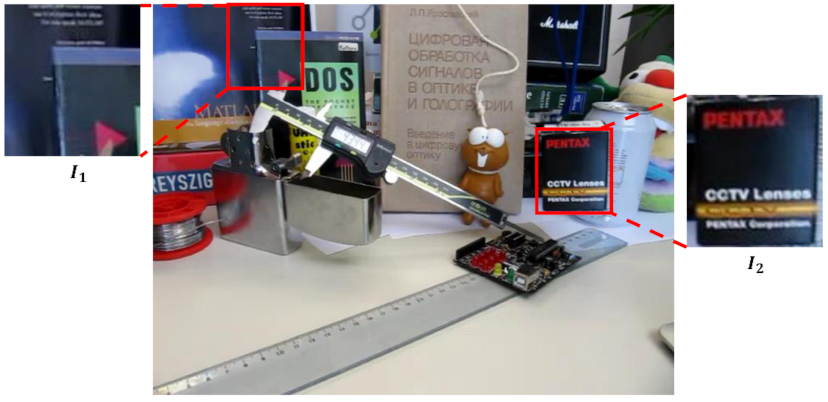

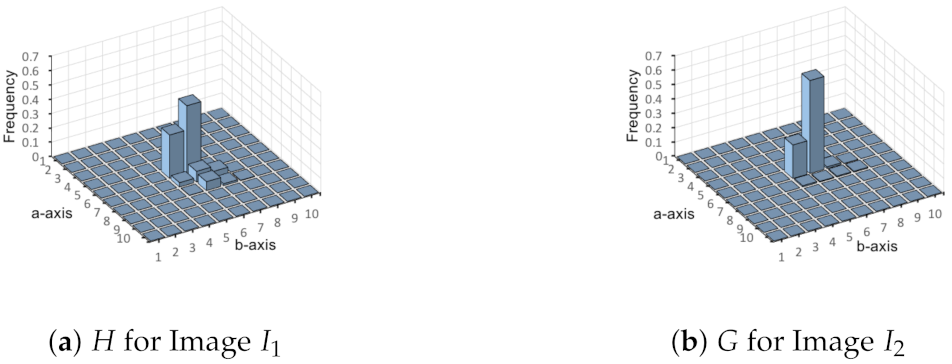


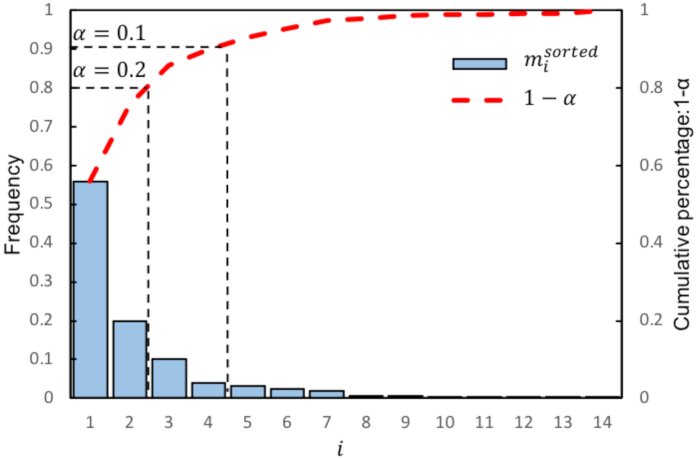
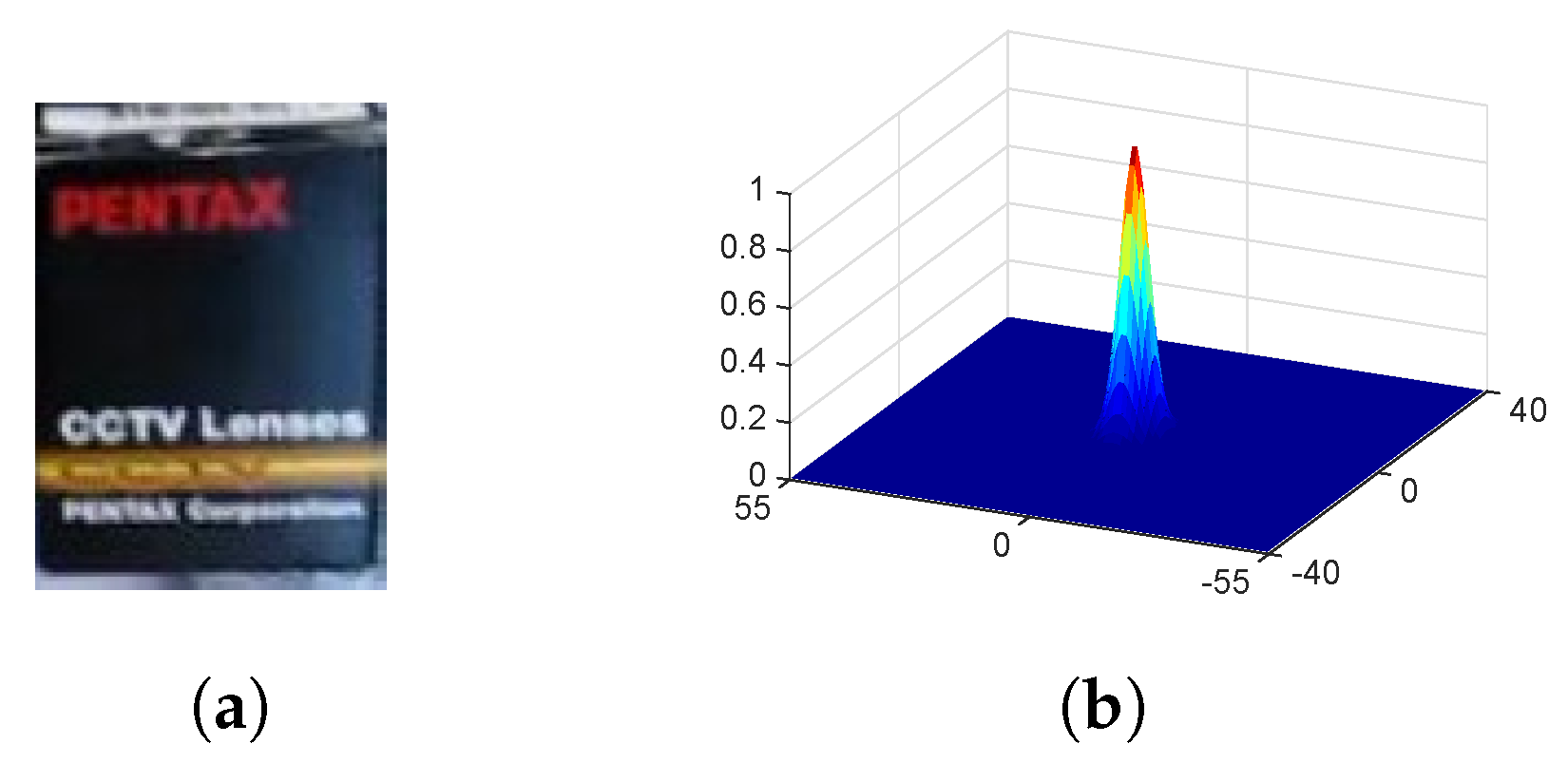
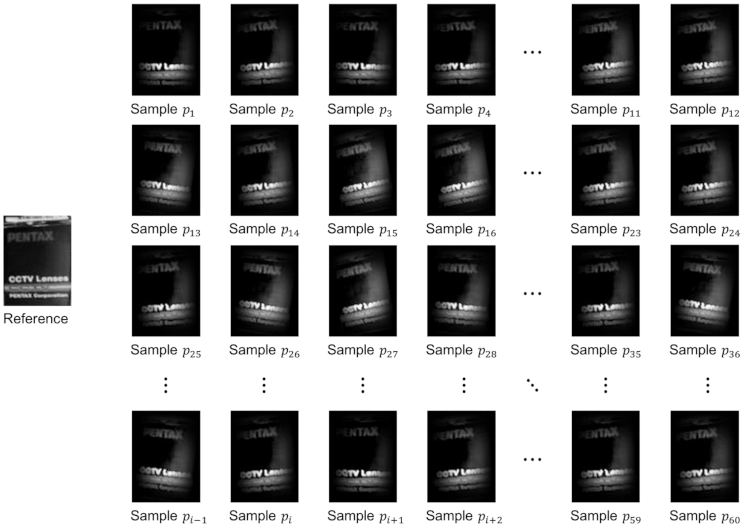
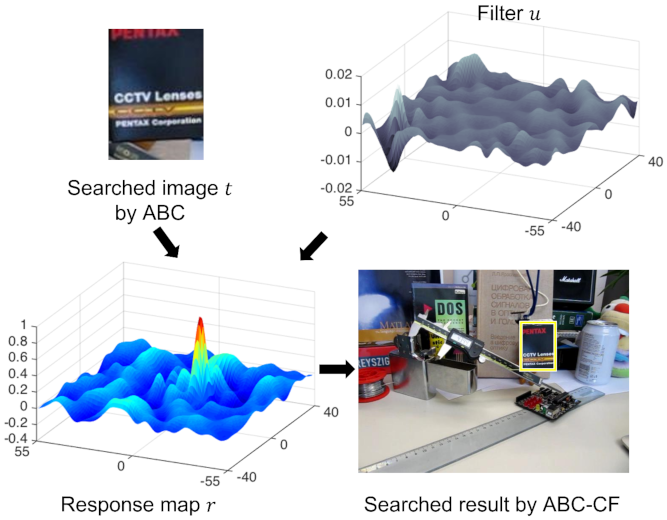
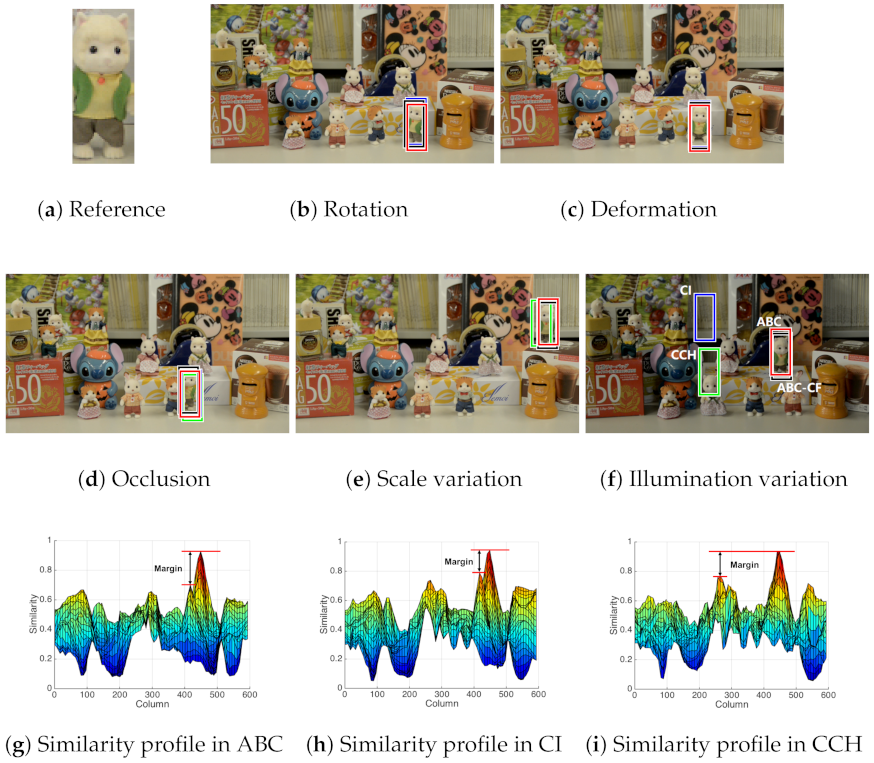

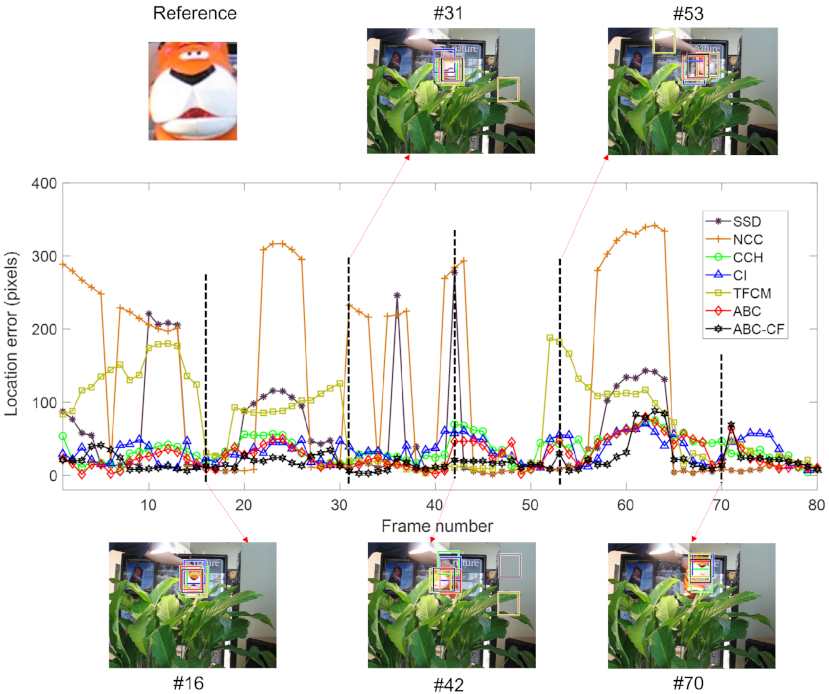

| CI | CCH | ABC | ABC-CF | |
|---|---|---|---|---|
| Rotation | 3.79 | 2.23 | 9.19 | 3.16 |
| Deformation | 2.82 | 6.09 | 9.16 | 5.09 |
| Occlusion | 12.04 | 21.63 | 10.66 | 4.46 |
| Scale variation | 3.41 | 12.16 | 3.70 | 3.16 |
| Illumination variation | 190.96 | 164.76 | 9.05 | 3.60 |
| SSD | NCC | CCH | CI | TFCM | ABC | ABC-CF | |
|---|---|---|---|---|---|---|---|
| Computation cost | 0.024 s | 0.026 s | 5.34 s | 3.83 s | 5.82 s | 7.56 s | 8.05 s |
Publisher’s Note: MDPI stays neutral with regard to jurisdictional claims in published maps and institutional affiliations. |
© 2021 by the authors. Licensee MDPI, Basel, Switzerland. This article is an open access article distributed under the terms and conditions of the Creative Commons Attribution (CC BY) license (https://creativecommons.org/licenses/by/4.0/).
Share and Cite
Tian, Y.; Kaneko, S.; Sasatani, S.; Itoh, M.; Fang, M. Robust and Precise Matching Algorithm Combining Absent Color Indexing and Correlation Filter. Information 2021, 12, 428. https://doi.org/10.3390/info12100428
Tian Y, Kaneko S, Sasatani S, Itoh M, Fang M. Robust and Precise Matching Algorithm Combining Absent Color Indexing and Correlation Filter. Information. 2021; 12(10):428. https://doi.org/10.3390/info12100428
Chicago/Turabian StyleTian, Ying, Shun’ichi Kaneko, So Sasatani, Masaya Itoh, and Ming Fang. 2021. "Robust and Precise Matching Algorithm Combining Absent Color Indexing and Correlation Filter" Information 12, no. 10: 428. https://doi.org/10.3390/info12100428
APA StyleTian, Y., Kaneko, S., Sasatani, S., Itoh, M., & Fang, M. (2021). Robust and Precise Matching Algorithm Combining Absent Color Indexing and Correlation Filter. Information, 12(10), 428. https://doi.org/10.3390/info12100428






